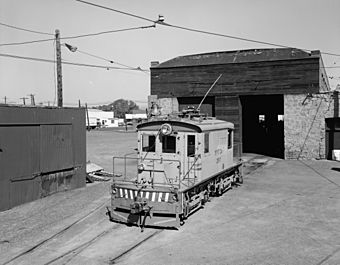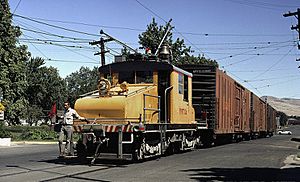Yakima Valley Transportation Company facts for kids
| Overview | |
|---|---|
| Headquarters | Yakima, Washington |
|
Yakima Valley Transportation Company
|
|

Yakima Valley Transportation Company boxcab electric locomotive #297.
|
|
| Lua error in Module:Location_map at line 420: attempt to index field 'wikibase' (a nil value). | |
| Location | Third Ave. and Pine St., Yakima, Washington |
| Area | 50 acres (20.2 ha) |
| Built | 1907 |
| Built by | Multiple |
| NRHP reference No. | 84004012 |
| Added to NRHP | October 8, 1992 |
| Reporting mark | YVT |
| Locale | Washington |
| Dates of operation | 1907–1985 |
| Technical | |
| Track gauge | 4 ft 8 1⁄2 in (1,435 mm) standard gauge |
| Electrification | 600 V DC trolley wire |
The Yakima Valley Transportation Company (YVT) was an electric railway in Yakima, Washington. It ran electric trains and streetcars. It also provided bus service for the city. The company operated from 1907 until 1985.
How the YVT Started
The YVT Company began running on December 25, 1907. It started as a streetcar line in downtown Yakima. At first, streetcars were the main focus. The company also carried some freight (goods).
Over time, the YVT expanded its lines. In 1910, a line went west to Ahtanum and Wiley City. Another line started towards Henrybro. By 1913, a line north to Selah and Speyers was finished.
Since 1909, the Union Pacific Railroad owned the YVT. The YVT's freight division helped move goods to the Union Pacific's main lines. Freight service grew a lot in the 1910s. By 1920, carrying freight became a very important part of the YVT's business. Passenger service on the interurban lines stopped on May 15, 1935.
City Transit Services
The Yakima Valley Transportation Company ran the city's streetcar system. It was the only company to do so from 1907 until 1947. The first streetcars were bought from the Danville Car Company. Later ones came from the John G. Stephenson Company and the J. G. Brill Company.
In the 1920s, YVT started trying out buses. In 1926, the company asked to replace all streetcars with buses. But the city said no. As more cars appeared, streetcar ridership went down. Cars also caused traffic jams in downtown Yakima.
The last streetcar ran on February 1, 1947. YVT kept running the local bus service until 1957. The city of Yakima then took over the bus service that year.
Freight Operations and Legacy
The YVT railroad continued to operate for many years. It only carried freight, connecting to the Union Pacific main line. In the 1970s, the city and YVT/Union Pacific agreed on something new. A heritage streetcar service could use the YVT tracks and overhead wires.
This special service began in 1974. Volunteers from a non-profit group called Yakima Valley Interurban Lines ran it. This group later became Yakima Valley Trolleys. This heritage service still runs today, though on a smaller scale.
Due to less money coming in, Union Pacific decided to close the YVT. They asked for permission on April 26, 1984. This was approved on June 5, 1985. The YVT officially stopped running on November 18, 1985.
However, the Union Pacific Railroad gave the entire railroad to the City of Yakima. This allowed the Yakima Valley Trolleys to keep running the heritage streetcar service. This group is a non-profit run by volunteers.
The donation included two of the YVT's three electric trains. These were the 1909 "Line car" A (used for maintaining the overhead wires) and the 1922 GE "steeple-cab" locomotive No. 298. The third YVT electric train, a 1923 boxcab-type No. 297, went to the Orange Empire Railway Museum. It left Yakima the day after the YVT closed.
Union Pacific kept the stone building where the trains were stored. But they agreed to let the city use it for only $100 a year. The YVT was one of the last freight railroads in North America to use trolley poles on its trains. It never switched to pantographs.


